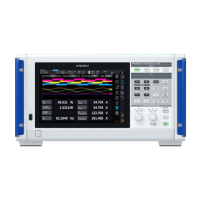75
Measuring Harmonic
What is THD?
THD, which stands for total harmonic distortion factor, is a ratio of the RMS value of the harmonic
content to the RMS value of the fundamental component or the reference fundamental component
of an alternating quantity.
What is grouping?
The harmonic measurement determines the number of the window waves depending on the
harmonic mode and the fundamental wave frequency. When the number of window waves is
other than one, spectrum lines (output bin), the number of which is proportional to the number
of the window waves ([number of window waves] − 1), can be acquired between the harmonic
components having a frequency of a whole number multiple of (n times) the fundamental wave.
They are known as the intermediate harmonic (inter-order harmonic).
Since measured values yielded by harmonic measurement dier depending on how these
intermediate harmonics are treated, IEC and other standards dene grouping rules.
(n-1)th order harmonic nth harmonic
Intermediate harmonic
nth order harmonic with
the grouping disabled
nth order harmonic with the
grouping Type 1 enabled
nth order harmonic with the
grouping Type 2 enabled
(n+1)th order harmonic
In general, the Type 1 range is known as the harmonic sub-group, and the Type 2 range is known
as the harmonic group, which are calculated by determining the square-root of sum of squares the
output bins.
If no intermediate harmonic exists, or the number of the window waves is one in wideband
mode, measured values will agree regardless of what grouping method has been chosen. If
intermediate harmonics exist, measured harmonic values will generally exhibit the relationship of
OFF < Type 1 < Type 2.
Displaying Power Numerically

